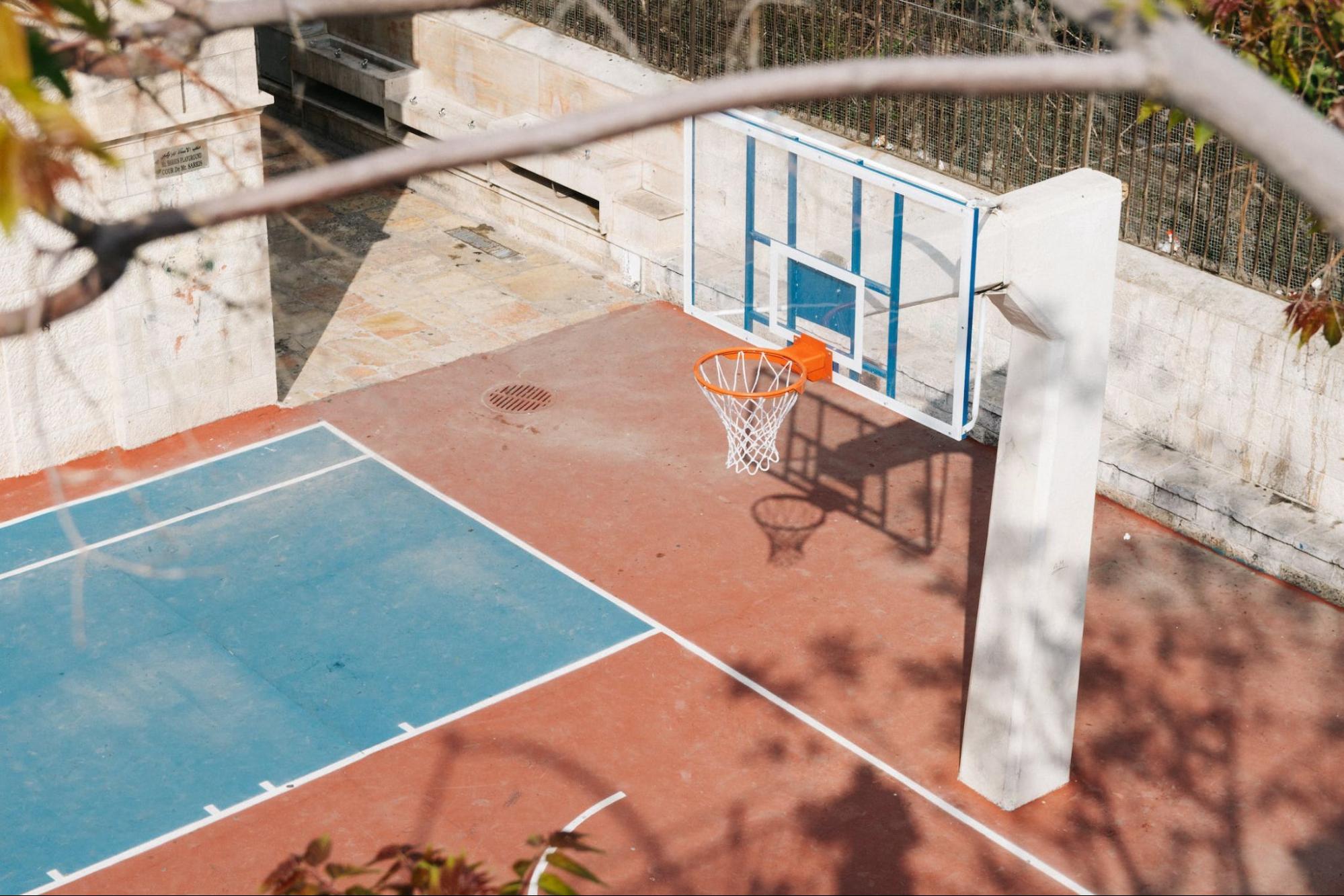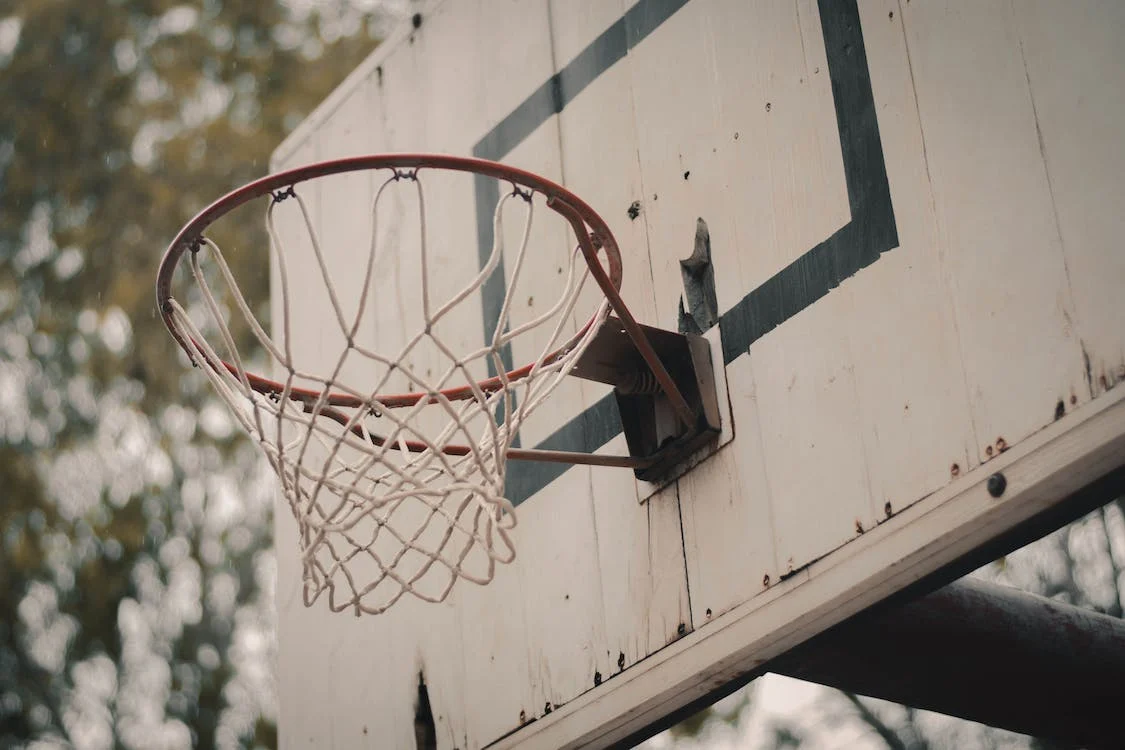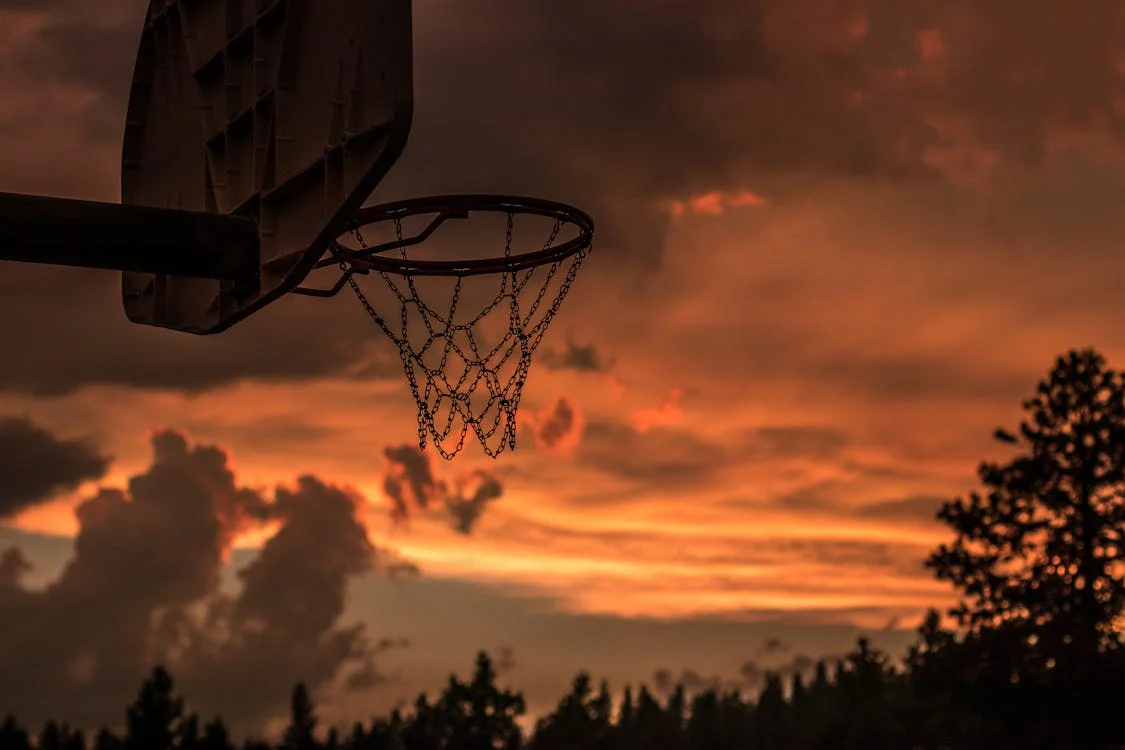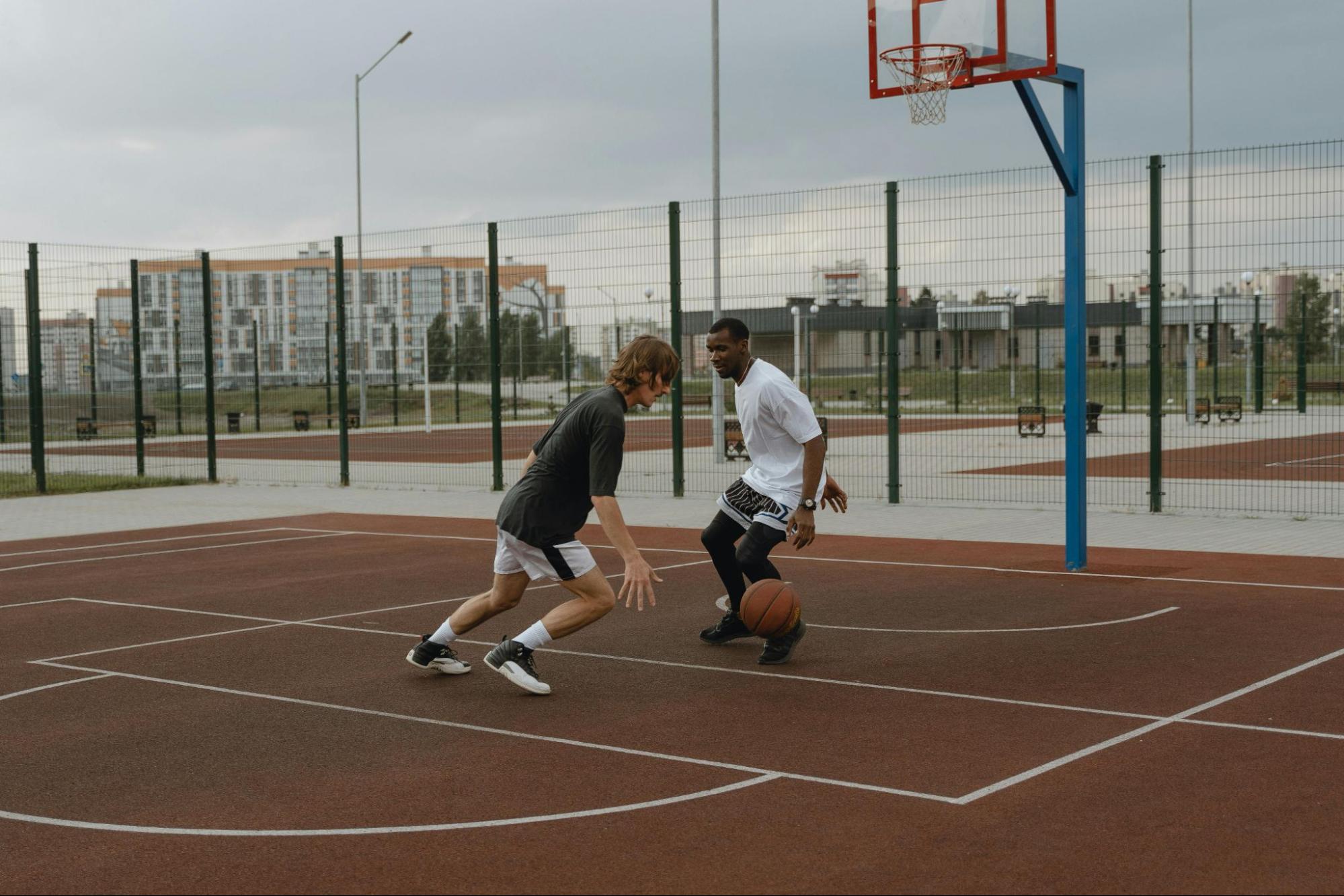Like any home renovation project, building a perfect basketball court in your backyard is limited by logistical issues. The standard size of a backyard basketball court largely depends on the space available and the level of play intended.
If you want to create your own backyard basketball court, this guide will help you cover the building basics and some maintenance tips too.
What Are the Best Measurements for a Backyard Basketball Court?
The typical dimensions for a full-size backyard court would be 28m long and 15m wide, mirroring professional basketball court dimensions. However, you don’t have to match these specifications strictly.
A backyard basketball court doesn’t need to follow professional dimensions. The size can be adjusted based on the following variables:
- Available space
- Number of players
- Preferred style of play
Creating the perfect backyard basketball court means tailoring these elements to fit your specific needs. Doing so ensures that the court remains a versatile space for both practice and play.
You can confidently work on your backyard project by keeping these factors in mind:
Court Dimensions
A half-court setup might be more feasible for those with limited space or just looking for recreational play. Basketball half court dimensions are typically 14m long and 15m wide. This provides ample space for shooting, dribbling, and practicing basic basketball maneuvers.
Below is a table giving the rough dimensions you can work with when designing your backyard basketball court.
|
Court Type |
Length (feet) |
Width (feet) |
Rim Height (feet) |
|
Full court |
94 |
50 |
10 |
|
Half-court |
47 |
50 |
10 |
Remember, these are just estimates since your own backyard basketball court dimensions can be adjusted to fit your specific needs and available space.
Out-of-Bounds Zone
It’s important to note that the dimensions in the table above do not include out-of-bounds areas. This is why you need to factor in an allowance for free horizontal and vertical space when planning basketball court dimensions.
In terms of the height of basketball hoops, the standard is 10 feet from the ground to the rim. This is consistent across all levels of play, from youth leagues to professional games.
Customization
Customization is also a common practice when it comes to backyard basketball courts. The size can be adjusted to fit the available space to allow enough areas for functional play.
For instance, a three-point line can be added even to a smaller court as long as there is enough room for players to shoot from that distance.
How Does the Size of a Backyard Basketball Court Affect the Game?
The size of a backyard basketball court can significantly influence gameplay and player movement. It allows for a more dynamic and strategic game, closely mimicking the experience of playing on a professional court.
Here are some ways basketball court dimensions can affect game dynamics:
- Three-point lines: A three-point line expands the range of play and strategic options for players, even inside half court dimensions.
- Free throw lines: Including a free throw line and free throw lane allows players to practice standard basketball plays and techniques.
- Proximity: In a smaller court, reduced space limits player movement and typically results in a faster-paced game with more close-range shots.
While changing the court’s size can influence the game in many ways, the essential elements of basketball will remain the same. Shooting, passing, dribbling,and teamwork are still present regardless of the court size.
Factors to Consider for Determining the Size of Your Backyard Basketball Court

When determining the size of your backyard basketball court, several factors should be considered. Accounting for these variables will help ensure that your backyard court is functional, safe, and enjoyable for all players.
Available Space
The first and most obvious factor is the amount of space you have available. Measure your backyard carefully, considering any existing structures or landscaping features that could interfere with the court.
Remember to leave enough space around the court for players to move safely. This is crucial when considering basketball court dimensions, especially if you plan to include a free throw line and three-point line.
|
Space For Spectators: If you have enough room to spare, designate an area for spectators so more people can enjoy your backyard basketball court. |
Purpose of the Court
The purpose of the court will also influence its size. If the court is primarily for casual play or children’s games, basketball half court dimensions may be enough to provide a compact yet functional play area.
However, if you plan to use the court for more competitive or structured games, you must be more strict with measurements. You must install durable and standardized basketball hoops and allow enough room for the free-throw lane to keep a dynamic play area.
Budget
Your budget will also play a role in determining your backyard court’s size.
Larger courts require more materials and labor to install, which can increase the cost. When setting your budget, consider the cost of materials, installation, and ongoing maintenance.
Legal Restrictions
Before you start planning, check with your local municipality or homeowners association if any restrictions or permits are required for building a basketball court. Some areas may have restrictions on the size, location, or even the color of backyard courts.
Safety Considerations
Safety should always be a priority when designing your court.
Ensure there is enough space around the court for players to move without running into obstacles. Consider the type of surface material as well, as some materials can be slippery when wet or hard on the joints.
Lighting
If you plan to use the court in the evenings, consider the current lighting in your backyard. You may need to install additional lighting to ensure the court is usable after dark.
Remember to consider your neighbors when planning lighting to avoid light pollution. Proper lighting is especially important for the visibility of the basketball hoops, free throw lines, and three-point lines during evening play.
Drainage
Consider the drainage in your backyard since a court prone to flooding or water pooling will not be usable after heavy rain.
You may need to install additional drainage or grade the court to ensure water runs off properly, keeping the basketball court dimensions clear and playable regardless of the weather.
Cost and Installation of a Backyard Basketball Court

The cost of installing a backyard basketball court can vary based on the following variables:
- Size of the court
- The type of surface material used
- Additional features (such as lighting or fencing)
A full-size court will generally cost more than a half-court due to the greater amount of materials and labor required. This is why many homeowners opt for a smaller court to better fit their backyard space and budget.
The type of surface material also plays a significant role in the overall cost. Concrete courts can cost between $4,500 and $9,000, while an asphalt court can range from $2,700 to $6,000.
Modular sports tiles or multi-purpose court surfaces can be used for homeowners seeking a more professional feel. These materials offer better performance and safety features but come with a higher price tag.
The actual net cost of your backyard basketball court project will depend on local labor rates, the specific layout of your backyard, and other factors. Always get multiple quotes and consider all options before making a decision.
What Materials Are Best for Backyard Basketball Courts?
NBA basketball courts use only two types of wood: Maple hardwood and Red Oak wood. While these can also be your pick for your backyard court, they will not last well when exposed to the elements.
The materials recommended for a backyard basketball court can vary depending on factors such as budget, personal preference, and local climate.
Here’s a brief overview of some common flooring options:
|
Material |
Pros |
Cons |
|
Asphalt |
It is affordable and durable |
Requires regular maintenance and can be hard on joints |
|
Concrete |
Very durable and has a professional look |
More expensive and can be hard on joints |
|
Modular sports tiles |
Easy to install and good shock absorption |
More expensive and can be slippery when wet |
|
Multi-purpose turf |
Soft and good for different sports |
Not ideal for competitive play and can be expensive |
The best material for your backyard basketball court depends on your specific needs and circumstances. It’s always a good idea to consult with a professional to make the best choice.
|
Winter Care: If you live in a region with harsh winters, consider how to protect your court during this season. This may involve removing the hoop and net, covering the court, or using a specific cleaning method to remove snow and ice without damaging the court surface. |
What Are the Safety Measures to Consider When Installing a Backyard Basketball Court?
Although your personal basketball court is built for casual play, you shouldn’t sleep on making it a safe space. When installing a backyard basketball court, safety should be a top priority.
Here are some key aspects you need to account for:
Surface Material
The surface material of the court should be non-slip to prevent accidents. Concrete, asphalt, and modular sports tiles are popular options due to their durability and safety features.
Court Layout
The court should be designed in a way that minimizes the risk of players running into obstacles or off the court. Ensure enough space around the court for players to move and stop safely.
Lighting

If you plan to use the court in the evening or at night, proper lighting is essential. Lights should be positioned so they illuminate the entire court without creating glare or shadows that could interfere with play.
Fencing
Installing a fence around the court can prevent balls from going into neighboring properties or into areas of your yard where they could cause damage. The fence can also serve as a safety barrier for young children.
Equipment
The basketball hoop and any other equipment should be securely installed to prevent them from falling over during play. Padding can be added to the pole of the basketball hoop to prevent injuries.
Supervision
Safety measures can vary depending on the specific circumstances of your backyard and the people who will be using the court. If young children will be using the court, adult supervision is recommended to ensure they are playing safely.
How to Maintain a Backyard Basketball Court
Maintaining a backyard basketball court involves several key steps to ensure its longevity and safety. Here are some best practices you can add to your maintenance tasks:
- Regular cleaning: It’s important to keep the court surface clean. This includes sweeping or blowing off leaves, dirt, and other debris that can cause slipping hazards or damage the court surface.
- Surface inspection: Regularly inspect the court surface for any signs of wear and tear, such as cracks or fading. Early detection of these issues can prevent them from turning into more extensive damage and costly repairs.
- Resurfacing: Depending on your court surface’s material, it may need to be resurfaced every few years. This involves applying a new layer to restore its appearance and performance.
- Net and hoop maintenance: Check the basketball net and hoop regularly for any signs of damage. Replace the net if it’s frayed or torn, and ensure the hoop is securely attached and not bent or rusted.
- Line marking: The court lines may fade over time due to weather and use. Repaint the lines as needed to keep them clear and visible.
Perfecting Your Backyard Basketball Experience

Creating a backyard basketball court that meets your needs involves careful consideration of basketball court dimensions and their impact on the game. Whether you opt for a full-size court to mimic professional matches or a half-court for recreational play, the key is customization to fit your available space and gameplay needs.
The perfect backyard basketball court can become a cherished space for friends and family to gather, compete, and enjoy the game. If you want to find the right tools to build your dream court at home, browse our product catalog at Quality Hoops.
Our wide selection of basketball hoops, outdoor basketball goals, and ceiling-mounted hoops can fit any and all courts of different shapes and sizes. Order from us and build your dream backyard basketball court today!






Leave a comment